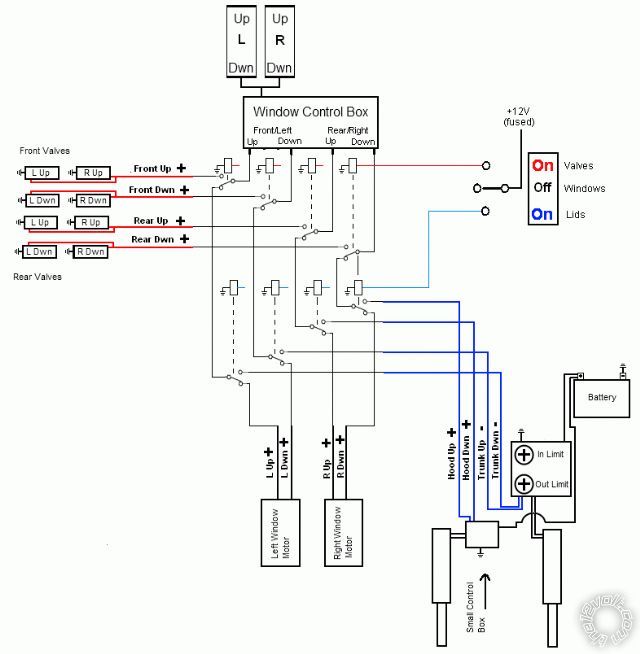Ah! I thought the "upper" valves were window motors... d'oh!
Damned people and their interpretations...
Like how stupid would you be if you interpreted the "three scenarios" to be three time-shifted depiction from left to right?
Of course you wouldn't know because you drew it in "real time" with the three "systems" from left to right!
I never would have expected such a logical or obvious layout.
Your are devious - you must know the sorts of diagrams I put up with.
NOTE! I am having fun. And it is a
MY expense - NOT yours.
(Just in case OPs think I am having a go at them as some poor OP from UAE did recently when a replier (also) LOL'd at his (IMO) humorous(?) depiction of "words to his contractors". Another non-existent
problem that flamed into the bit bucket....)
Now having wasted another half a page....
And having reconsidered...
... and eaten egg....
GREAT! Even better!
Now, until I get to putting this diagramatically ....
Picture each of your "Relay" as being two relays - one under the other. Hence 2x2 relays = 4 total.
Each relay is DPDT - ie 2 pole changeover.
The top relay's NC contact #87a connects to the next (under) relay's input (#30), and its NO #87 goes to valves.
Hence if the top relay is energised the WCB (Window Control Box) output is
diverted to the valves.
Otherwise....
The bottom relay is similarly connected with NO (Normally Open) #87 to the actuator/s, and its NC #87a to the windows.
Hence with the lower relay energised, the WCB output goes to the actuators.
If neither relay is actuated, the WCB output is connected to the windows (thru Normally Closed NC contacts #87a).
Now, 4 relays.
The upper 2 are for (say) valves.
The lower 2 are (thus) for actuators.
The 2 left-side relays are (say) for LHS window or front valves or bonnet... er, hood.
The 2 right-side relays are (this) for RHS window or rear valves or boot... er, trunk.
Obviously..... the assigning of left to front or rear is subject to
your local convention else is arbitrary.
But the
front valve should IMO be the same window-switch direction as
front actuator hood/bonnet.
And we should all know that boots are up the rear! (That's another LOL...?)
And each relay has 2 poles - one for up, & one for down signals from the WCB.
Else 2 SPDT repays could be used with their coils (#85 & #86) in parallel.
So 4x DPDT else 8x SPDT relays as far as simple "switch decoding" and "up/down" to each of the targets goes.
I like it.
But it seems too simple. What a I missing.... (Forget "pulses" etc - that's separate.)
But this is an extension of my original diagram which uses hot switching instead of GND switching (and where relays negate the use of blocking diodes). (It also demonstrates how GND switching or Open-Collector outputs or "inverted logic" can greatly simplify circuitry.)
And no diodes are required - unless coil-spike suppression is required, but it shouldn't be since the WCB control motors; maybe using relays itself?
So Mr Smarty Boot, tell me where I've gone wrong this time!


Now, I'll get to modifying your diagram....
[Warning - I use "circuits" rather than "relay housing" depictions. That's because I want to easily trace the connections & operation. (Plus I rarely use Hella/Bosch type relays!)]
 Printable version
Printable version












 I realize it only shows 2 relays, but think of those 2 as the block of relays that will be needed.
The different colors show the direction of the rocker, and what the corresponding devices will be operating. Red On, will be going to the valve assembly, Black Off will be controlling the power windows, and Blue On will be going to the actuators.
Does this make more sense, or do I need to redraw it a different way? Just trying to be clear as to what I want the final outcome to be.
Thanks
Shawn
I realize it only shows 2 relays, but think of those 2 as the block of relays that will be needed.
The different colors show the direction of the rocker, and what the corresponding devices will be operating. Red On, will be going to the valve assembly, Black Off will be controlling the power windows, and Blue On will be going to the actuators.
Does this make more sense, or do I need to redraw it a different way? Just trying to be clear as to what I want the final outcome to be.
Thanks
Shawn


 Now, I'll get to modifying your diagram....
[Warning - I use "circuits" rather than "relay housing" depictions. That's because I want to easily trace the connections & operation. (Plus I rarely use Hella/Bosch type relays!)]
Now, I'll get to modifying your diagram....
[Warning - I use "circuits" rather than "relay housing" depictions. That's because I want to easily trace the connections & operation. (Plus I rarely use Hella/Bosch type relays!)]

